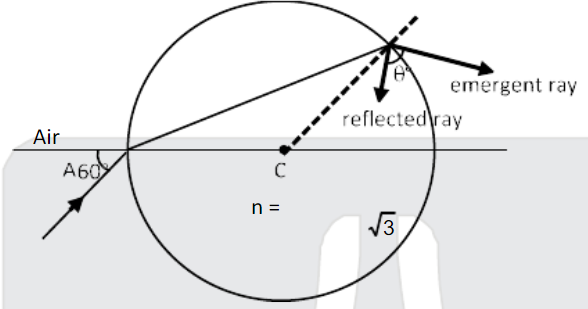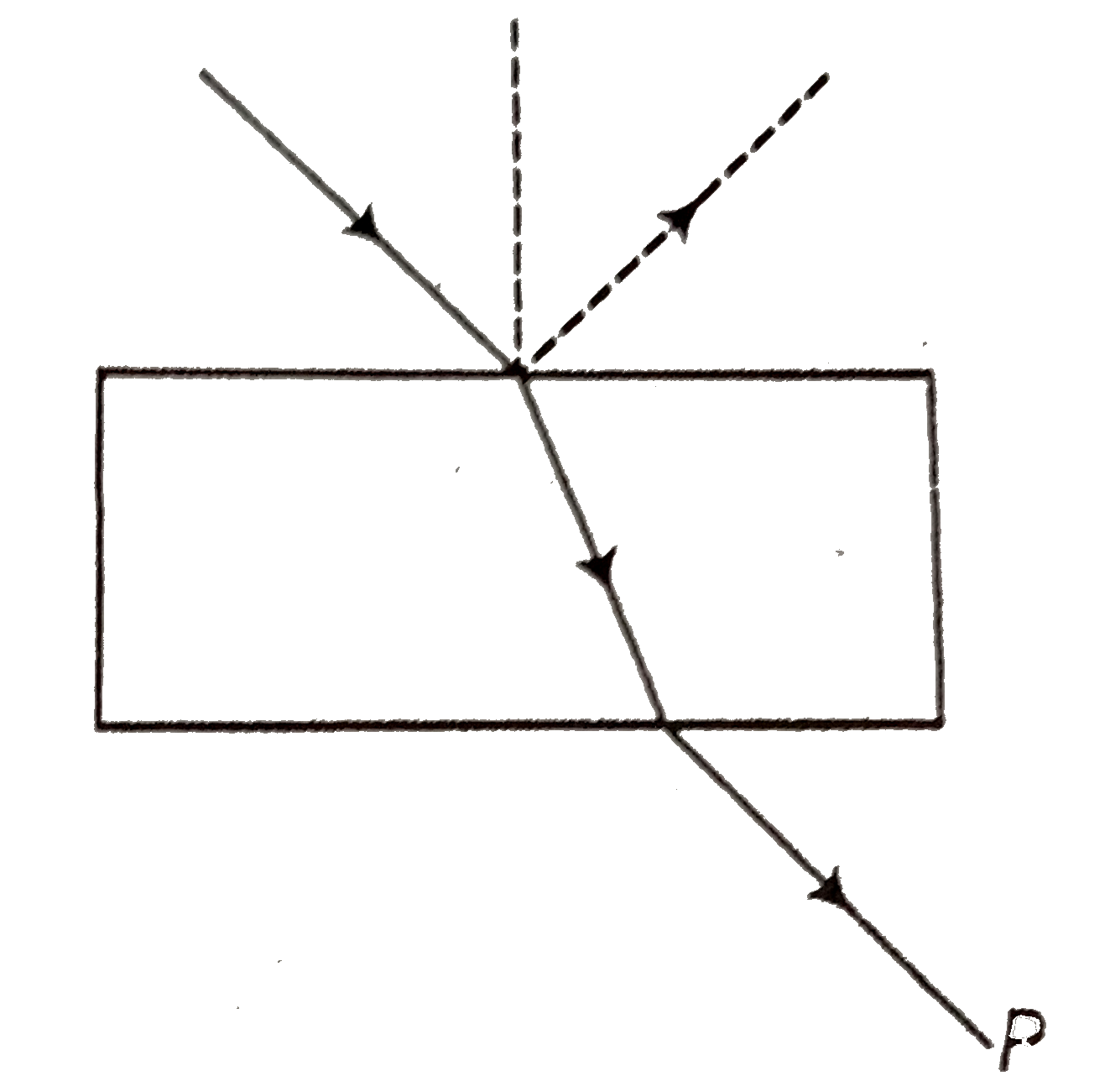Consider a light beam incident from air to a glass slab at Brewster's angle as shown in Figure.

A polaroid is placed in the path of the emergent ray at point P and rotated an axis passing through the centre and perpendicular to the plane of the polaroid.
For a particular orientation there shall be darkenss as observed through the polaroid.
The intensity of light as seen through the polaroid shall be independent of the rotation.
The intensity of light as seen through the Polaroid shall go through a minimum but not zero for two orientations of the polaroid.
The intensity of light as seen through the polaroid shall go through a minimum for four orientations of the polaroid.
The correct Answer is:C
According to Brewster's law, the light reflected from the top of glass slab gets pilarised, Fig. The light refracted into the glass slab and the light emerging from the glass slab is only partially polarised. Therefore, when a polaroid is held in the path of emergent light at P, and rotated about an axis passing through the centre and perpendicular to plane of polaroid, the intensity of light shall go through a minimum but not zero for two orientations of the polaroid.
Therefore, choice (c ) is correct.
Topper's Solved these Questions
- OPTICSBook:PRADEEPChapter:OPTICSExercise:Problems for practice
Explore 4 Videos
- OPTICSBook:PRADEEPChapter:OPTICSExercise:Comprehension 1
Explore 1 Video
- OPTICSBook:PRADEEPChapter:OPTICSExercise:Value based questions
Explore 3 Videos
- MAGNETIC EFFECT OF CURRENT AND MAGNETISMBook:PRADEEPChapter:MAGNETIC EFFECT OF CURRENT AND MAGNETISMExercise:Competition Focus (Multiple Choice Questions)
Explore 2 Videos
Similar Questions
A light ray is incident on a plane glass slab of thickness ‘t’ at an angle of incidence ‘i’ as shown in the figure. If μ is the refractive index of glass. Then find time taken by the light ray to travel through the slab.
View SolutionLight incidence on a sphere of refractive index √3 placed in a air as shown in Figure. Find the angle (θ)in degree between emergent ray and reflected ray.

View Solution
Knowledge Check
Consider a light beam incident from air to a glass slab at Brewster's angle as shown in figure.
A polaroid is placed in the path of the emergent ray at point P and rotated about an axis passing through the centre and pependicular to the plane of the plaroid.
 Afor a particular orientation, there shall be darkness as observed through the polaroidBThe intensity of light as seen through the polaroid shall be independent of the rotationCThe intensity of light as seen through the polaroid shall go through a minimum but not zero for two orientations of the polaroidDThe intensity of light as seen through the polaroid shall go through a minimum for four orientations of the polaroid
Afor a particular orientation, there shall be darkness as observed through the polaroidBThe intensity of light as seen through the polaroid shall be independent of the rotationCThe intensity of light as seen through the polaroid shall go through a minimum but not zero for two orientations of the polaroidDThe intensity of light as seen through the polaroid shall go through a minimum for four orientations of the polaroidA short pulse of white light is incident from air to a glass slab at normal incidence. After travelling through the slab, the first colour to emerge is.
AblueBgreenCvioletDredA rays of light is incident on a thick slab of glass of thickness t as shown in figure. The emergent ray is parallel to the incident ray but displaced sideways by a distance d. If the angles are small then d is
 At(1+ir)Brt(1−ir)Cit(1−ri)Dt(1+ri)
At(1+ir)Brt(1−ir)Cit(1−ri)Dt(1+ri)
A ray of light AO in vacuum is incident on a glass slab at angle 60∘and refracted at angle 30∘ along OB as shown in the figure.The optical path length of light ray from A to B is
View SolutionA plane mirror reflecting a ray of incident light is rotated through an angle of 30∘ about an axis through the point of incidence in the plane of the mirror and perpendicular to the plane of incidence then
View SolutionA plane mirror, reflecting a ray of incident light, is rotated through an angle θ about an axis through the point of incidence in the plane of the mirror perpendicular to the plane of incidence, then
View SolutionA plane mirror, reflecting a ray of incident light, is rotated through an angle θ about an axis through the point of incidence in the plane of the mirror perpendicular to the plane of incidence, then
View SolutionA ray of light is incident on a parallel-sided glass slab as shown in the figure. The angle of refraction for this ray of light is likely to be :

View Solution

